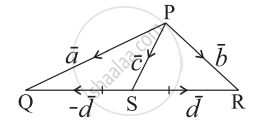Advertisements
Advertisements
प्रश्न
If A(1, 2, – 3) and B(– 1, – 2, 1) are the end points of a vector `vec("AB")` then find the unit vector in the direction of `vec("AB")`.
उत्तर
`vec("AB")` = P.V. of B – P.V. of A
= (– 1, – 2, 1) – (1, 2, – 3)
= (– 1 – 1, – 2 – 2, 1 + 3)
= (– 2, – 4, 4)
= `-2hat"i" - 4hat"j" + 4hat"k"`
`|vec("AB")| = sqrt((-2)^2 + (-4)^2 + 4^2)`
= `sqrt(4 + 16 + 16)`
= `sqrt(36)`
= 6
∴ Unit vector along
`vec("AB") = vec("AB")/|vec("AB")|`
= `(-2hat"i" - 4hat"j" + 4hat"k")/6`
= `(-1)/3(hat"i" + 2hat"j" - 2hat"k")`
APPEARS IN
संबंधित प्रश्न
If \[\overrightarrow{a}\], \[\overrightarrow{b}\], \[\overrightarrow{c}\] are the position vectors of the vertices of a triangle, then write the position vector of its centroid.
If \[\overrightarrow{a}\] and \[\overrightarrow{b}\] denote the position vectors of points A and B respectively and C is a point on AB such that 3AC = 2AB, then write the position vector of C.
If D, E, F are the mid-points of the sides BC, CA and AB respectively of a triangle ABC, write the value of \[\overrightarrow{AD} + \overrightarrow{BE} + \overrightarrow{CF} .\]
If \[\overrightarrow{a} = \hat{i} + \hat{j} , \vec{b} = \hat{j} + \hat{k} \text{ and }\vec{c} = \hat{k} + \hat{i} ,\] write unit vectors parallel to \[\overrightarrow{a} + \overrightarrow{b} - 2 \overrightarrow{c} .\]
Find a unit vector in the direction of \[\overrightarrow{a} = 2 \hat{i} - 3 \hat{j} + 6 \hat{k}\].
Let G be the centroid of ∆ ABC. If \[\overrightarrow{AB} = \vec{a,} \overrightarrow{AC} = \vec{b,}\] then the bisector \[\overrightarrow{AG} ,\] in terms of \[\vec{a}\text{ and }\vec{b}\] is
If \[\vec{a}\text{ and }\vec{b}\] are two collinear vectors, then which of the following are incorrect?
Find the components along the coordinate axes of the position vector of the following point :
Q(–5, 1)
In the given figure express `bar"c"` and `bar"d"` in terms of `bar"a"` and `bar"b"`.

Find the coordinates of the point which is located in the YZ-plane, one unit to the right of the XZ- plane, and six units above the XY-plane.
Let `bara = hati - hatj, barb = hatj - hatk, barc = hatk - hati.` If `bard` is a unit vector such that `bara * bard = 0 = [(barb, barc, bard)]`, then `bard` equals ______.
Find the component form of `bar"a"` if it lies in YZ-plane makes 60° with positive Y-axis and `|bar"a"| = 4`.
Two sides of a parallelogram are `3hat"i" + 4hat"j" - 5hat"k"` and `-2hat"j" + 7hat"k"`. Find the unit vectors parallel to the diagonals.
Let bar"b" = 4hat"i" + 3hat"j" and bar"c" be two vectors perpendicular to each other in the XY-plane. Find the vector in the same plane having projection 1 and 2 along bar"b" and bar"c" respectively.
State whether the expression is meaningful. If not, explain why? If so, state whether it is a vector or a scalar:
`bar"a".(bar"b" xx bar"c")`
State whether the expression is meaningful. If not, explain why? If so, state whether it is a vector or a scalar:
`bar"a". bar"b" + bar"c"`
If `bar"a", bar"b", bar"c"` are three non-coplanar vectors show that `(bar"a".(bar"b" xx bar"c"))/((bar"c" xx bar"a").bar"b") + (bar"b".(bar"a" xx bar"c"))/((bar"c" xx bar"a").bar"b") = 0`
Using vectors, prove that cos (A – B) = cosA cosB + sinA sinB.
If `vec"a" = hat"i" + hat"j" + 2hat"k"` and `hat"b" = 2hat"i" + hat"j" - 2hat"k"`, find the unit vector in the direction of `2vec"a" - vec"b"`
Let `bara, barb` and `barc` be three vectors, then `bara xx (barb xx barc) = (bara xx barb) xx barc` if
Four vectors `veca, vecb, vecc` and `vecx` satisfy the relation `(veca.vecx)vecb = vecc + vecx` where `vecb * veca` ≠ 1. The value of `vecx` in terms of `veca, vecb` and `vecc` is equal to
If two or more vectors are parallel to the same line, such vectors are known as:
If `veca = hati - hatj + 7hatk` and `vecb = 5hati - hatj + λhatk`, then find the value of λ so that the vectors `veca + vecb` and `veca - vecb` are orthogonal.
Find `|vecx|` if `(vecx - veca).(vecx + veca)` = 12, where `veca` is a unit vector.
Check whether the vectors`2hati+2hatj+3hatk,-3hati+3hatj+2hatk and 3hati +4hatk` form a triangle or not.
In the triangle PQR, `bar(PQ)=2bara` and `bar(QR)=2barb`. The mid-point of PR is M. Find following vectors in terms of `bara and barb`.
(i) `bar(PR)` (ii) `bar(PM)` (iii) `bar(QM)`
Check whether the vectors `2hati + 2hatj + 3hatk, -3hati + 3hatj + 2hatk and 3hati + 4hatk` form a triangle or not.
In the triangle PQR, `bar"PQ" = bar"2a", bar"QR" = bar"2b"`. The midpoint of PR is M. Find the following vectors in terms of `bar"a"` and `bar"b"`:
(i) `bar"PR"` (ii) `bar"PM"` (iii) `bar"QM"`.
